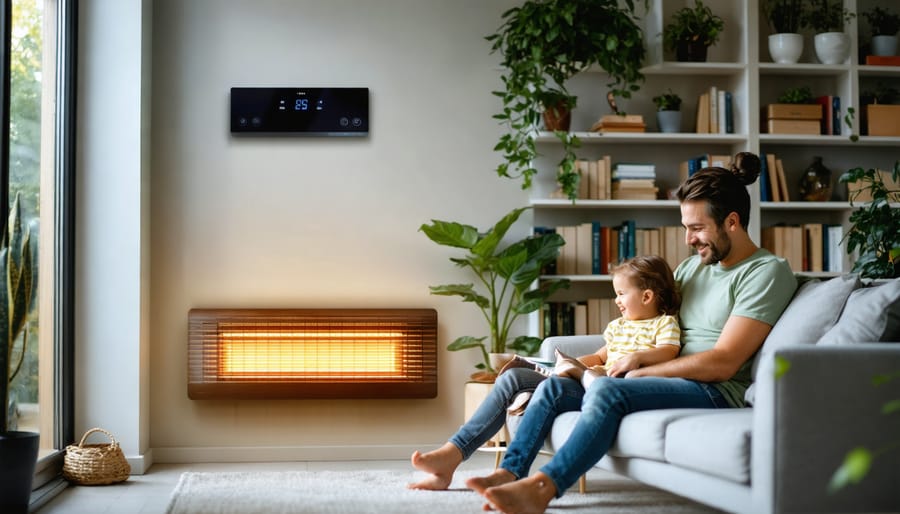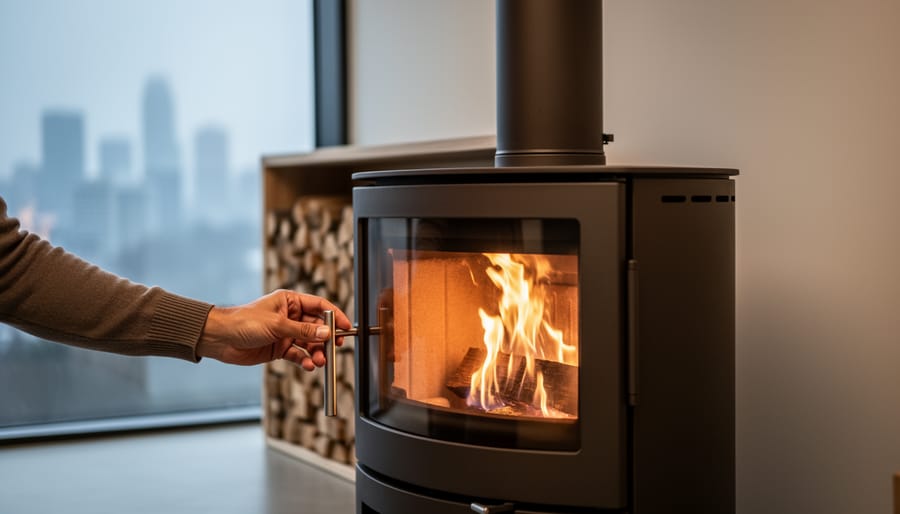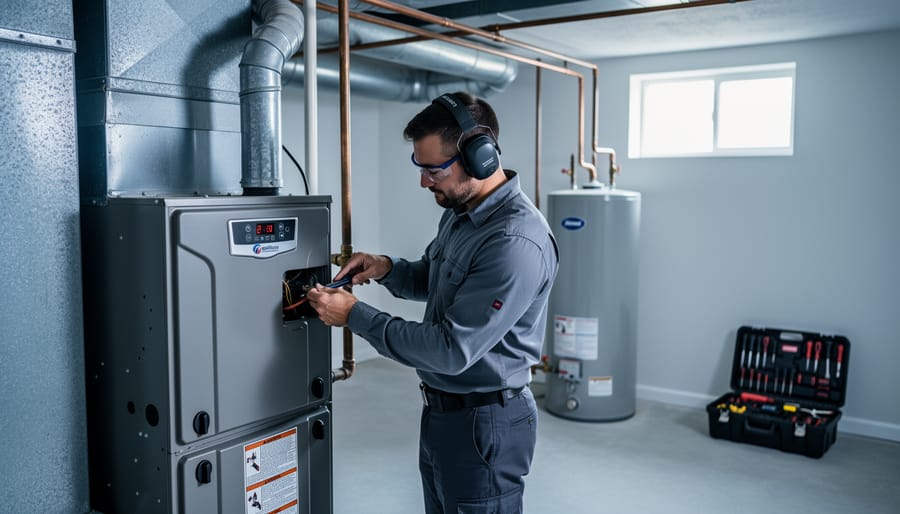**Infrared heating is safe when used correctly**—and understanding exactly why can transform your approach to home comfort. Unlike traditional heating that warms the air (and all its dust), infrared heaters work like the sun, delivering gentle, direct warmth through electromagnetic waves that pose no health risks at safe distances. The confusion often stems from misunderstanding “radiation”—a term that sounds alarming but simply describes how heat travels, not nuclear or harmful UV exposure.
Your concerns about bringing infrared heating into your home are valid. You’re making a significant investment in your family’s comfort and deserve clear, evidence-based answers about potential health effects, fire safety, and long-term reliability. The truth is, infrared heaters eliminate many traditional heating hazards—they don’t produce carbon monoxide, won’t dry out your air, and operate at lower surface temperatures than baseboard heaters.
What makes infrared heating particularly appealing for eco-conscious homeowners is its efficiency: it warms people and objects directly rather than wasting energy heating entire rooms of air. This targeted approach means lower electricity bills and a smaller carbon footprint—making it both a safe and sustainable choice for modern homes seeking that perfect balance of warmth, ambiance, and environmental responsibility.
What Is Infrared Heating and How Does It Work?
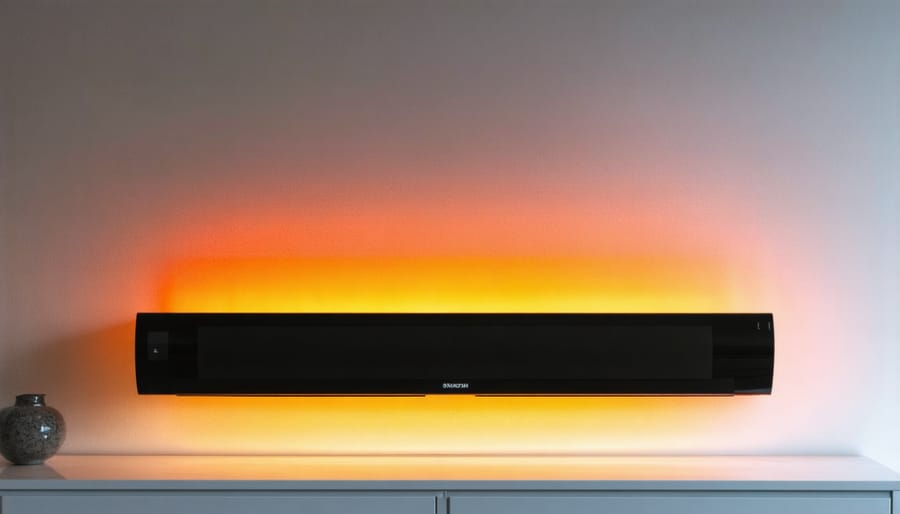
The Science Made Simple
Think of infrared heating like the gentle warmth you feel from the sun on a cool morning—it’s the same natural energy that’s been keeping us warm since the beginning of time. Unlike traditional heaters that warm the air around you (which then rises to the ceiling), infrared heaters work by sending out invisible light waves that heat objects and people directly, just like sunshine warming your face.
These infrared waves sit on the electromagnetic spectrum between visible light and microwaves—completely different from the harmful UV rays that cause sunburn or the X-rays used in medical imaging. There’s no radiation risk here; we’re talking about the same gentle radiant heat your own body naturally produces and that cozy fireplace radiates into your living room.
When an infrared heater warms your favorite reading chair or heats the floor beneath your feet, those objects then release that warmth gradually back into your space. It’s wonderfully efficient because the heat goes exactly where you need it—warming you and your belongings—rather than being wasted heating empty air that floats away. This makes infrared heating not only safe but also an eco-friendly choice for homeowners looking to create comfortable warmth without the energy waste of conventional heating systems.
How Infrared Differs from Traditional Heating
Traditional heating systems work by warming the air around you—think of your furnace pushing hot air through vents or baseboard heaters creating convection currents. The air circulates, gradually raising the room temperature, but heat can escape quickly when doors open or drafts occur.
Infrared heating takes a fundamentally different approach. Rather than heating air, it emits invisible light waves that travel through space and warm objects directly—your furniture, walls, floors, and yes, you. It’s the same gentle warmth you feel from sunlight streaming through a window or the radiant heat from a crackling fireplace.
This direct heating method offers several advantages. You feel warmth almost immediately rather than waiting for air to circulate. There’s no blowing air, which means less dust circulation and no drying out of your indoor environment. The heat also stays more consistent since you’re not relying on air that can easily escape.
When comparing infrared vs oil filled heaters or forced-air systems, infrared typically uses less energy to achieve the same comfort level. This makes it an appealing eco-friendly heating solution for homeowners seeking both efficiency and the cozy ambiance of radiant warmth.
Health and Safety: Separating Facts from Fiction
Does Infrared Heating Emit Harmful Radiation?
Let’s clear up a common concern right away: infrared heating is completely different from the harmful radiation you might be worried about. Think of it this way—the electromagnetic spectrum is like a vast radio dial, with different types of energy at different positions. On one end, you have radio waves and microwaves. In the middle, there’s visible light and infrared radiation. At the far end, you’ll find the potentially harmful stuff like ultraviolet rays, X-rays, and gamma rays.
Infrared radiation sits comfortably in the safe zone, right next to the visible light we see every day. In fact, it’s the same type of warmth you feel from sunlight streaming through your window or the gentle heat radiating from your fireplace. It’s non-ionizing radiation, which means it doesn’t have enough energy to damage your cells or DNA—unlike UV rays or X-rays.
Your body actually produces and absorbs infrared energy naturally as part of its heat regulation. When you use an infrared heater, you’re simply experiencing the same kind of radiant warmth that humans have enjoyed from fires and sunshine throughout history. There’s no mysterious or dangerous energy at play here—just clean, natural heat that warms objects and people directly, creating that cozy ambiance we all love in our homes.
Air Quality and Respiratory Health Benefits
One of the most appreciated benefits of infrared heating is how gentle it is on your indoor air quality. Unlike traditional forced-air systems that constantly blow air around your home, infrared heaters work silently through radiant heat. This means they don’t stir up dust, pet dander, or other allergens that might be lurking in your carpets and furniture—a significant advantage if you or your family members deal with allergies, asthma, or other respiratory sensitivities.
Traditional heating systems can also dramatically reduce indoor humidity levels, leaving the air uncomfortably dry and irritating your throat, sinuses, and skin. Infrared heating, however, doesn’t affect moisture levels in your home. The air stays naturally comfortable without that parched feeling you might associate with cranking up the heat during winter months.
For homeowners seeking a healthier heating solution, this makes infrared technology particularly appealing. You get the cozy warmth you’re looking for without compromising the air you breathe. Many users with respiratory conditions report noticeable improvements in their symptoms after switching to infrared heating, enjoying a more comfortable home environment where they can breathe easier throughout the colder months.
Skin Safety and Burn Prevention
One of the most common concerns about infrared heating is whether it can damage your skin or cause burns. The good news? When used properly, infrared heaters are remarkably safe and comparable to other heat sources you already trust in your home.
Think about sitting beside a crackling wood-burning fireplace on a winter evening—that cozy warmth you feel on your face is actually infrared heat. Similarly, the gentle warmth of sunlight streaming through your window contains infrared rays. Infrared heaters work on the same principle, delivering radiant heat that warms objects and people directly rather than just heating the air.
The key to skin safety is maintaining appropriate distances. Most manufacturers recommend staying at least three feet away from infrared heating panels or space heaters during operation. Unlike conventional heaters that can have dangerously hot surfaces, infrared panels typically operate at lower surface temperatures, reducing the risk of contact burns.
Extended direct exposure at close range could potentially cause mild skin dryness, similar to sitting too close to any heat source. However, infrared heaters don’t emit UV radiation—the harmful component in sunlight that damages skin—making them gentler than direct sun exposure. Simply position your infrared heater thoughtfully, enjoy the warmth from a comfortable distance, and you’ll experience all the benefits of this eco-friendly heating solution without any skin safety concerns.

What About Children and Pets?
Infrared heaters are generally safe around children and pets when used thoughtfully, making them a family-friendly heating option for your home. Unlike traditional space heaters with exposed coils or flames, infrared panels typically feature cool-to-touch surfaces or protective grills, reducing burn risks. However, placement is key—mount wall panels at least 6-7 feet high, well beyond curious little hands and jumping pets, and always position portable units where they won’t be knocked over during playtime.
Create a “no-touch” zone around any heating unit and teach children that heaters are off-limits, just as you would with your fireplace. For homes with toddlers or particularly curious pets, consider models with built-in tip-over switches and automatic shut-off features for added peace of mind.
The gentle, consistent warmth infrared heating provides means no sudden temperature fluctuations or hot air blasts that might startle pets or dry out children’s sensitive skin. Since these systems don’t blow dust or allergens around your home, they’re especially beneficial for families with asthma or allergies. Just ensure adequate ventilation in the room and never leave portable heaters unattended when young children or pets are present—the same common-sense approach you’d take with any heating appliance in your cozy, well-heated home.
Fire Safety and Electrical Concerns
Fire Risk: What You Need to Watch For
Like any heating appliance, infrared heaters require respect and proper use, but the good news is that modern units come equipped with thoughtful safety features that dramatically reduce fire risk. Understanding these protections—and following basic guidelines—helps you enjoy cozy warmth without worry.
The primary fire concern with any heater is proximity to flammable materials. Infrared heaters need adequate clearance around them to operate safely. Most manufacturers recommend keeping at least three feet of space between your heater and combustibles like curtains, furniture, bedding, or papers. Always check your specific model’s requirements, as these can vary. Wall-mounted and ceiling-mounted infrared panels actually offer an advantage here, since they’re positioned well away from floor-level hazards.
Modern infrared heaters incorporate multiple layers of protection. Tip-over switches automatically shut off the unit if it’s knocked over—a crucial feature if you have pets or children. Overheat protection sensors monitor internal temperatures and cut power before components can reach dangerous levels. Many quality models also feature cool-touch exteriors or protective grills, preventing burns from accidental contact.
Surface temperatures vary by heater type. While infrared panels typically remain relatively cool, portable infrared heaters with visible elements do get hot during operation. This is normal and safe when used correctly, but it underscores the importance of proper placement and supervision.
When it comes to leaving infrared heaters on overnight, built-in safety features provide peace of mind, though following manufacturer guidelines remains essential. Never use extension cords with infrared heaters—plug directly into wall outlets to prevent overheating. Regularly inspect cords for damage, keep heaters on stable, level surfaces, and never use them in damp locations unless specifically rated for such use.
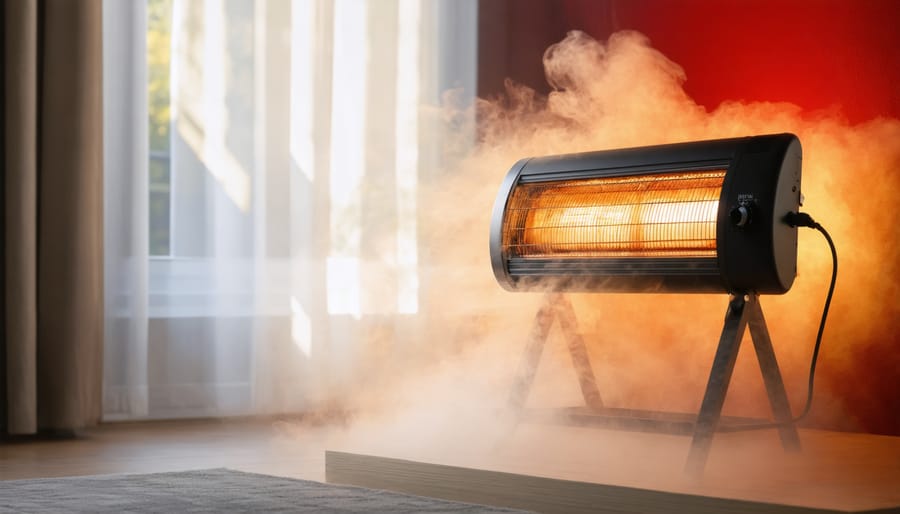
Electrical Safety and Installation Standards
While infrared heaters are wonderfully efficient additions to your home’s comfort system, they do require careful attention to electrical safety—much like any heating appliance. Understanding the basics ensures your cozy space remains both warm and secure.
First, consider your home’s electrical load capacity. Infrared heaters typically draw between 1,000 to 1,500 watts, which means they should ideally have a dedicated circuit to prevent overloading. Plugging multiple high-wattage devices into the same outlet can trip breakers or, in worst cases, create fire hazards. Think of your electrical system as having a limited “energy budget”—you want to spend it wisely.
Proper wiring is non-negotiable for safe operation. Always ensure your infrared heater is plugged directly into a grounded wall outlet, never through an extension cord or power strip. These connectors aren’t designed to handle sustained high-wattage loads and can overheat. If your desired placement requires professional hardwiring—particularly for mounted ceiling panels or permanent installations—this is when calling a licensed electrician becomes essential.
Speaking of professionals, don’t hesitate to consult an electrician if you’re uncertain about your home’s electrical capacity, notice flickering lights when the heater runs, or plan to install multiple units. They can assess whether your circuit breaker panel needs upgrading and ensure all connections meet local building codes. This small investment in professional expertise protects your home and maximizes your heating system’s longevity.
Safety Certifications to Look For
When shopping for an infrared heater, think of safety certifications as your peace of mind guarantee. These marks confirm that independent testing laboratories have thoroughly evaluated the product for potential hazards. Look for the UL (Underwriters Laboratories) mark, which is the gold standard in North America for electrical safety testing. The ETL (Intertek) certification offers similar assurance and is equally trustworthy. If you’re in Canada, the CSA (Canadian Standards Association) mark is essential.
These certifications mean the heater has passed rigorous tests for electrical safety, fire resistance, and proper operation. Before making your purchase, check the product label or description for at least one of these marks. Avoid deeply discounted models without any recognizable safety certification—they might save you money initially but could pose serious risks to your home and family. Reputable manufacturers proudly display their certifications, so if you can’t find this information easily, that’s a red flag worth heeding as you create a safer, warmer living space.
Safe Usage: Best Practices for Your Home
Placement and Clearance Guidelines
Proper placement is essential for maximizing both comfort and safety when using your infrared heater. Think of it as creating a warm, inviting atmosphere while respecting the heater’s space requirements—much like you’d carefully position a traditional fireplace.
Always maintain at least three feet of clearance from furniture, curtains, bedding, and other combustible materials. This breathing room prevents fabrics from getting too warm and ensures optimal heat distribution throughout your space. Wall-mounted units need six inches of clearance on all sides, while portable models work best when positioned away from high-traffic areas where they might be knocked over.
Never place infrared heaters directly beneath wall outlets or in bathrooms where moisture is present. Keep them away from water sources entirely, as electricity and dampness don’t mix. If you’re using a portable unit, position it on a flat, stable surface—never on furniture or shelving.
For rooms with children or pets, consider mounting your heater higher on the wall or choosing models with cool-touch exteriors and protective grills. This eco-friendly heating solution performs beautifully when given proper space to radiate warmth efficiently. Remember, adequate clearance isn’t just about safety—it’s about creating that cozy, comfortable environment you’re seeking while allowing your heater to function at its best.
Daily Operation Tips
Getting the most from your infrared heater while maintaining safety is straightforward when you follow a few practical guidelines. Think of it as creating a cozy, efficient heating routine that becomes second nature.
Set your thermostat to a comfortable range between 68-72°F for optimal efficiency. Unlike traditional heating systems that need to warm up gradually, infrared heaters deliver immediate warmth, so there’s no need to crank up the temperature. This targeted approach is part of optimizing your heating system while keeping energy costs down.
Turn your unit on about 15 minutes before you need the warmth—that’s all it takes. When leaving a room for extended periods, switch it off. While many models include automatic shut-off features, developing this habit prevents unnecessary energy consumption and reduces any minimal fire risk.
Common mistakes to avoid include placing heaters too close to furniture (maintain at least three feet clearance), covering the unit while it’s operating, or using extension cords instead of direct wall outlets. Never drape clothing over your heater to dry—this blocks airflow and creates a fire hazard.
Clean your heater’s surface monthly with a dry cloth when it’s cool and unplugged. Dust buildup reduces efficiency and can affect performance. Finally, resist the temptation to run multiple high-wattage appliances on the same circuit, which can overload your electrical system and compromise safety.
Maintenance for Long-Term Safety
The beauty of infrared heaters is that they’re remarkably low-maintenance, but a little regular attention goes a long way in keeping them safe and efficient for years to come. Think of it like tending to a favorite fireplace—simple care ensures optimal performance.
Start with monthly dust removal using a soft, dry cloth when the unit is cool and unplugged. Dust buildup can reduce heating efficiency and, in rare cases, create fire hazards. For reflective panels, a gentle wipe maintains their effectiveness at directing heat where you need it most.
Every season, inspect the power cord for fraying, the plug for discoloration, and the heating element’s protective grill for damage. These quick visual checks take just minutes but catch potential problems before they become safety concerns.
Watch for warning signs that service is needed: unusual odors beyond initial “new heater” smells, strange sounds, inconsistent heating, or the unit cycling on and off frequently. These symptoms suggest it’s time for professional attention.
Most quality infrared heaters require minimal professional maintenance, but following manufacturer guidelines for annual inspections—especially for permanent installations—ensures your eco-friendly heating solution remains both safe and effective, giving you peace of mind throughout countless cozy evenings.
Infrared Heating as an Eco-Friendly Choice
When you choose infrared heating for your home, you’re making a decision that’s as kind to the planet as it is safe for your family. This heating technology stands out among eco-friendly heating options because of how efficiently it works with nature rather than against it.
Unlike conventional heating systems that waste energy warming air that rises to the ceiling or escapes through drafts, infrared heaters deliver warmth directly where you need it. This targeted approach means you’re using significantly less energy to achieve the same comfort level—often reducing energy consumption by 30-50% compared to traditional heating methods. Lower energy use translates directly into a smaller carbon footprint and reduced utility bills, creating a win-win situation for both your wallet and the environment.
The safety advantages we’ve discussed throughout this article also contribute to infrared heating’s eco-friendly profile. Because these heaters don’t burn fuel, they produce zero emissions in your home—no carbon monoxide, no combustion byproducts, and no pollutants released into the atmosphere. They also don’t dry out the air or circulate dust and allergens, maintaining healthier indoor air quality without requiring additional humidifiers or air purification systems.
The longevity of infrared heaters further enhances their environmental credentials. With fewer moving parts and no combustion elements to wear out, these units typically last longer than conventional heaters, reducing waste and the need for frequent replacements. When you invest in infrared heating, you’re choosing a sustainable heating solution that keeps your family safe while respecting the environment for generations to come.
After exploring the science, health considerations, and practical guidelines surrounding infrared heating, the evidence is clear: infrared heating is indeed safe when used properly. This technology offers a natural, efficient way to warm your home without the air quality concerns associated with traditional heating methods. There’s no harmful radiation to worry about—just the same gentle warmth you feel from sunlight on a crisp morning.
The key to enjoying infrared heating safely lies in making informed choices. Select certified products from reputable manufacturers, follow installation guidelines carefully, and practice common-sense safety measures like maintaining proper clearances and regular inspections. When you treat your infrared heater with the same respect you’d give any home appliance, it becomes a reliable companion in creating the cozy atmosphere you’ve always wanted.
Beyond safety, infrared heating brings eco-friendly benefits that align beautifully with sustainable living goals. Lower energy consumption, zero emissions, and efficient zoned heating make it an intelligent choice for environmentally conscious homeowners who refuse to compromise on comfort. Whether you’re drawn to the ambiance of an infrared fireplace or seeking supplemental warmth for specific spaces, this proven technology can safely enhance your home’s comfort for years to come.

